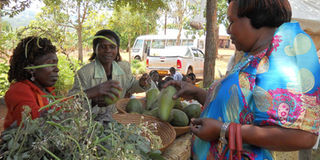Prime
Farmer’s Diary: How to blend horticulture with animal farming

A farmer checks avocado fruits. It is possible for farmers to grow and make profit out of vegetables and frutis alongside other farming activities. PHOTO BY MICHAEL J. SSALI
The ideas in today’s column are drawn from a speech made last week by Mr Peter Dhaki, a farmer in Itenga Village, Mukungwe, Masaka District. It was titled: “Is horticulture a viable business to small holder farmers?”
Mr Dhaki, the chairperson, Akamireyiye Farmers Group, was addressing agriculture scientists and researchers from Burundi, Kenya, Tanzania, Kenya, and Uganda. They were in his compound to see the farmers’ group exhibition, which was also one of the activities for the launch of the second phase of the Crop-livestock Integration Project, which aims at enhancing food security and resilience climate change effects.
It’s possible
Mr Dhaki said, “As members of Akamireyiye, our experience and answer to the above question is in the affirmative. Yes, horticulture is such a viable business and a means to alleviate the poverty of small-scale farmers, especially women. The growing population, rural urban migration and the increasing scientific evidence aired on FM radio and TV stations and published in newspapers, stressing the importance of vegetables, greens and fruits for good health have created a big demand for horticultural products and hence an alternative income generating activity farmers can tap into.”
Mr Dhaki and his wife live right on the outskirts of Masaka Town, where majority of people buy all their food, including vegetables and fruits. His group comprises of zero-grazing cattle keepers who also grow vegetables and other crops. Masaka Town is the main market for all their products.
But how do Akamireyiye farmers manage to sustain their farming activities to satisfy the ever-growing demand of vegetables, fruits, milk and other farm products?
Plant-animal relationship
His home is a demonstration of how farmers can withstand drought and other hurdles facing them today. Despite the severe dry season, there are flourishing vegetable gardens on Dhaki’s farm. His three Friesian cows drink all their normal quantity water requirements and they are certainly well fed. He has a simply constructed underground water tank right in his compound with the capacity to hold 35,000 litres of water drawn from the house tap.
He has a foot operated water pump, which is connected by a water tube to a smaller tank at the vegetable gardens for irrigation. There are also bales of hay and a variety of preserved dry fodder grasses and leaves.
The animals produce manure, which Akamireyiye farmers use to grow the vegetables. Some of the cow’s droppings at Dhaki’s home are used to produce bio-gas for lighting the house and also for cooking food. Most of the technologies, as he pointed out, were achieved as a result of the two-year-partnership between grass root farmers’ groups and researchers from National Agricultural Research Organisation - under the Crop-livestock Integration Project whose second phase was being launched right there.
Mr Dhaki concluded by making the case for horticulture. “Rain water harvesting is a great innovation; access to irrigation water eases life and crop production will go on irrespective of rain seasons. Horticulture brings in daily income especially for farmers near towns with minimal strain to other farming activities,” he said. Mr Dhaki noted that many people have realised that it’s a viable business that can allow farmers access micro-credit thanks to an assured daily income.
“With access to water, the dry season brings in even better returns.
A balanced diet for the home is also assured. If children can learn that one can get money from a small project like growing vegetables, this may stop the practice of demeaning agriculture. For us we have reaped the benefits of horticulture and are planning to expand our gardens further to meet the growing demand for horticultural products,” he said.




